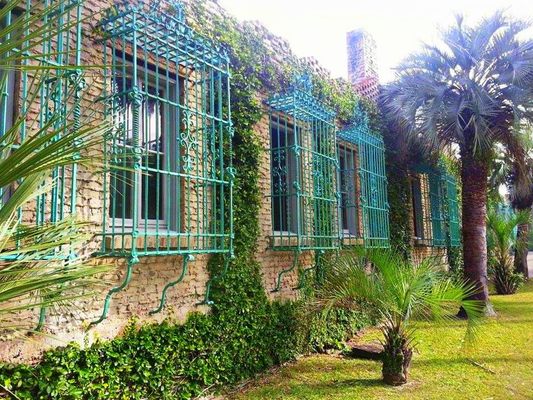About
This austere-looking structure that brings to mind terms like "fortress" or "castle" was in fact a vacation home for a well-to-do couple. Located a stone's throw from the beautiful Carolina coast, Atalaya once served as the winter home of Archer and Anna Huntington, who owned large swaths of the surrounding area.
Construction of Atalaya began in 1931 under the direction of Archer Huntington, who purportedly worked without the use of written guidelines and whose enthusiasm for Spanish history informed the Moorish architectural design. The one-story square structure encompasses roughly 40,000 square feet and includes an inner courtyard and a total of around forty-two rooms. Thirty of these rooms were living quarters while others were devoted to the couple's artistic and philanthropic pursuits.
By wintering in South Carolina, the Huntingtons sought to escape the harsh Northeastern winters to which they were accustomed. Anna Huntington, a noted sculptor, suffered from tuberculosis and hoped the warmer climes would improve her health. Several rooms in the house, including the largest room, were used as studio space. The Huntingtons kept numerous animals at Atalaya, including dogs, horses, and even bears, which Anna used as subjects for her sculptures. Her work was displayed on the adjoining property, which was developed concurrently with Atalaya and which is now home to the Brookgreen Gardens sculpture garden and nature preserve where many of Mrs. Huntington's statues are displayed.
The house forms a square border around the inner courtyard with each side measuring 200 feet in length. The tower in the center of the courtyard from which Atalaya's name is derived ("Atalaya" is Spanish for "watchtower") is actually a 300-gallon water tower. The tower's 40-foot height provided sufficient water pressure to supply the house's plumbing system. Heating was provided by wood-burning fireplaces and coal room heaters.
The Huntingtons last used Atalaya in 1947, eventually removing all their furnishings and leaving the house virtually empty. In the summer, one can find relief from the Carolina heat inside Atalaya's stone walls. A kitchen and bathroom still stand in the main quarters complete with an old cooking stove from the era and a claw foot bathing tub than many people loved to take photos in. So much so that the bathroom is now closed off to visitors, but can still be viewed from outside of its doors. You can smell the salt air and hear the waves crashing in the distance from this wing of the castle and it isn't hard to imagine yourself soaking while looking out over the lush greenery that lead to the sand dunes beyond.
Servants quarters are in the rear wing of the castle and they are aplenty. It took many people to keep this winter home running. Each room is basic and on the small side, but cosy with coal heaters built into the wall. Definitely a vast difference from the larger rooms that the Huntingtons and their guests used while staying at Atalaya.
Atalaya is located on the grounds of what is now Huntington State Park. Most visitors access the house through the park's main entrance, but those wishing to dodge the park's entry fee can wander in from a nearby beach via a footpath that leads through the dunes. If you take this route, be sure to keep your flip-flops handy, as the turf surrounding Atalaya is home to fire ants and some mean sand spurs.
Related Tags
Published
April 26, 2013































































